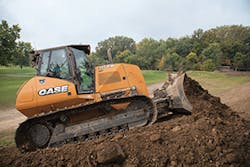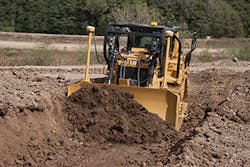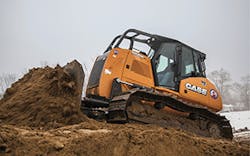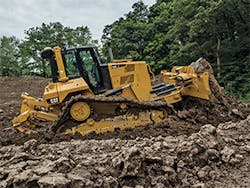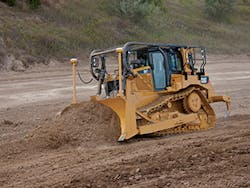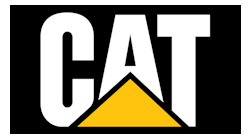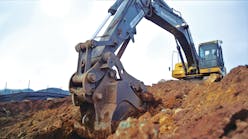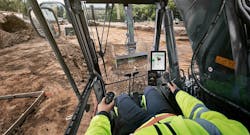Editor’s note: This article first appeared in the June 2016 issue of GX.
On construction sites, few machines are as important—or as challenging to operate—as dozers.
Just ask dozer operators who have struggled to hit grade on their job sites. How many extra passes do operators make to hit the right grade levels on a project? The mistakes of dozer operators can cost contractors money in lost time, wasted labor, and increased fuel consumption.
Smart machine technology is helping to change this, though. This technology, which includes grade control systems that help operators lift their blades at the perfect height and telematics that tell them how much time they’ve wasted in idle, can help even inexperienced dozer operators hit grade quickly and accurately.
A Caterpillar D6T dozer equipped with telematics
Manufacturers today are increasingly aware of how important smart machine technology is becoming, especially for vehicles like dozers that are notoriously difficult for inexperienced operators to master. It’s why John Deere launched its 700K SmartGrade Dozer at the World of Concrete convention in Las Vegas in January.
Shipments of this tech-enhanced machine were scheduled to begin March 1, says Liz Quinn, product marketing manager for John Deere WorkSight.
And John Deere isn’t alone. Manufacturers are increasingly offering smart machine systems with their dozers. A growing number of fleet owners are taking advantage of this by ordering those vehicles that come with grade control technology. These owners understand that smart machine technology can save their companies many dollars each year.
Tech Advancements
John Deere’s SmartGrade Dozer is a good example of what the industry offers today. This vehicle comes equipped with the Topcon 3D-MC2 grade control system. Because the system is integrated into the dozer’s cabin and software, it gives even inexperienced operators the ability to hit specific grade requirements on their job sites.
Quinn says that the new dozer also features key sensors on the machine. There is a slope sensor behind the blade and another on the body of the dozer. These sensors generate about 100 corrections every second. The system controls the position of the blade and the dozer itself.
“The system is able to sense when there is enough load on the blade that if the blade isn’t adjusted it will cause track slip,” says Quinn. “It makes sure that the operator lifts the blade up just enough so that the dozer can continue grading without slipping the tracks.”
Experienced operators have long relied on their own skills to perform this same feat. Quinn says veteran operators can sense when their dozers are taking on too much weight. Experienced operators can also—relying mostly on feel—hit their grades more often than not.
But newer operators? Hitting grade and operating a dozer efficiently are difficult challenges to master. Fleet operators can’t simply rely solely on hiring experienced operators, either. New operators are the future of the grading and excavation business. Many of the most experienced operators are reaching retirement age. This means that many of these less experienced workers will soon have to make their first attempts at operating dozers.
This is where smart machine technology comes in. By automating more of the grading process, machine control technology can turn inexperienced operators into skilled ones in a shorter period of time. And this can help improve the yearly profits that owners make. After all, when operators hit grade quickly—and they don’t have to go back over the same patch of land to fix their mistakes—it takes less time to complete jobs.
“With a new operator, learning how to master a dozer takes time. It takes some time for that new operator to get a good feel for that machine,” says Quinn. “You put a new operator in a SmartGrade dozer and much of the process is automated. The operator doesn’t need to get that feel to get the maximum push out of every pass without flipping the tracks.”
And the real bonus here? Smart machine controls benefit experienced operators, too.
Quinn says that veteran dozer operators use automated grade control systems often. The technology makes it easier for even these experienced pros to hit grade with more accuracy. These veteran operators can then complete their work in even less time.
“The reduction in wasted hours is one of the great benefits that come with using grade control on a machine,” says Quinn.
A Challenging Machine
Dozers can be challenging machines to run, especially for new operators. Sebastian Witkowski, product marketing manager for intelligent machine control for Komatsu America Corp., says that new operators lack the experience necessary to operate dozers as efficiently as possible.
These inexperienced operators are often slow to adjust their dozers to heavier loads. They might fail to make the adjustments necessary to avoid track slip, says Witkowski.
Machine control systems, though, shorten the time it takes for even inexperienced operators to efficiently operate a dozer, says Witkowski.
“Before the introduction of machine control, there was such a high learning curve for new operators,” says Witkowski. “It took skilled operators to efficiently rough sites, get close to grade, and get to the final finished grade. It wasn’t uncommon for skilled operators, even, to have to go back and redo some of their work to get to grade.”
Today, though, operators have grade-position information in their cabs, right at their fingertips, says Witkowski. And they receive this information in real time.
“There is no guessing,” says Witkowski.
Machine control technology today doesn’t just make it easier for dozer operators to hit their grade. It also lessens the challenges involved in rough dozing and rough cutting, says Witkowski.
This doesn’t mean that any operator can jump into a tech-enhanced dozer and hit perfect grade. Witkowski says operators still need to listen to their machines and make adjustments while dozing to boost their odds of hitting that right grade.
“The challenge now comes from knowing how to react to the machine,” he says. “The best operators will still rely on their experience and their ability to feel the machine’s response. Those operators who can do this will still be the ones who run their dozers the most efficiently. They will still be the best choice of owners who want to hit grade in the most efficient way possible.”
The main benefit that comes with machine control technology? Witkowski explains that this tech automatically lowers and raises dozer blades to the right level according to information that operators or owners input before the dozers start their grading work.
He adds that this technology empowers not just inexperienced dozer operators, but also those with decades of onsite experience. These experienced operators, who already have an innate feel for their machines and can tell when something is off, can also more efficiently tackle their jobs from the rough-cut, to the finish-grade stages of a job, says Witkowski.
It all depends on how different operators use the technology, he says.
“I will reiterate this: not only does this technology lower the learning curve for new operators, it is also a great benefit for experienced operators,” he says. “Traditionally, experienced operators will maybe not pay as much attention to the rough-cutting phase of a job. They will zero in using machine control technology when they get to the finish-blade part of the work. But there are benefits there, too, for the rough-cutting phase, which new operators can take advantage of. With machine control technology, operators can minimize track slip, for instance, ultimately increasing their productivity and efficiency.”
Mark Oliver, product marketing manager for crawlers and dozers with John Deere Construction & Forestry, says there is a reason why you so rarely see inexperienced operators on dozers: these are some of the most challenging vehicles on a job site.
“When you look at operators on a job site, you rarely find a brand-new person running a dozer, crawler, or excavator,” says Oliver. “Instead, they are the most experienced operators. Once you find an operator who you think might be able to one day become a dozer operator, you have to start training. It’s not a quick process.”
This holds true even for dozers equipped with smart machine technology, says Oliver.
“There is still an art to learning where to get the dirt from and where to put it,” he says. “You can become an OK operator in a couple of months. But it takes many, many months to become a great operator. A dozer really is one of the most difficult machines to learn how to operate.”
Witkowski says that experienced dozer operators are able to react to their machines quickly, thanks to the years they’ve spent running them. They might be able to tell if their machine’s blade load is too high. They might feel track slip and adjust accordingly.
But it’s not realistic for owners to ask for the same kind of responses from inexperienced operators, says Witkowski.
“The benefit to inexperienced operators is that our dozers equipped with machine control technology automatically sense blade load,” he says. “They automatically adjust to minimize track slip. The technology optimizes and makes sure that the blade is always full. With this technology, operators can get the most productivity and efficiency out of our dozers.”
CASE has had machine control
technology since 2013.
Oliver says that more experienced dozer operators are becoming less hesitant to embrace the features of machine control technology. They understand that this technology isn’t a way for owners to replace them with cheaper, less experienced labor, but rather a way for their bosses to provide them all the tools they need to become even more efficient.
“You can’t walk up to an experienced dozer operator and say that this technology is going to make them an even better operator,” says Oliver. “But you can tell these experienced operators that they now have access to the tools that allow them to become more efficient and put more of their experience to work. You can’t say that this one tool will make them even better than they are. But you can tell them that this technology will add even more value to their experience.”
A Growing Trend
Witkowski says that more fleet owners are requesting machine control technology in dozers, and that more operators are embracing the systems.
The reason is simple: machine control technology makes owners more profitable, he says.
When dozers equipped with machine technology roam job sites, it allows owners to cut out the work associated with grading stakes and surveyors. Owners can then place the grading work in the hands of operators and site foremen.
Caterpillar offers StableBlade with its dozers.
“You can see grade in real time and remove the work related to having to manage grade sticks and the guess work involved there,” says Witkowski. “Owners are seeing the benefits, too. When you turn around and roll these productivity savings into your bid process, you gain an advantage. You can bid lower for jobs. There is a chance for owners to get more work.”
When promoting smart machine technology for dozers, manufacturers emphasize the dollar savings that these systems will generate for fleet operators.
This makes sense: Machine control technology, though important for an efficient job site, isn’t free. Manufacturers have to demonstrate to owners that this technology will pay for itself over time.
Fortunately, proving this isn’t overly difficult.
“Grade control delivers a fantastic return on investment,” says Quinn. “Anyone who uses it will tell you that it pays back its worth in one job. You are essentially getting to grade faster. Each pass is more accurate. There is such a reduction in waste and fuel consumption that goes along with doing the job right rather than going back and forth trying to get it right.”
Becoming Standard
The biggest positive might be just how common machine control systems are becoming. The biggest names in the grading and excavation business have not been shy about introducing new technology designed to make grading an easier task, for both experienced and new dozer operators.
Caterpillar machine control is becoming common.
Sam Meeker, product application specialist with Caterpillar, says that the company has introduced a variety of features that make operating its dozers more intuitive. Meeker says that these features range from basic control assistance to full-featured automation systems.
For instance, Caterpillar now offers StableBlade with its dozers. This is an Inertial Measurement Unit-based feature that senses tractor movement while operators are running their dozers. StableBlade helps smooth the finish grade that operators are trying to hit, says Meeker.
This is key: Operators using this kind of machine technology will be able to complete jobs more accurately and in less time. That will help owners boost the bottom line of their grading and excavation businesses.
“This feature will allow smoother finish and faster operation with less effort from the operator,” says Meeker.
Caterpillar also equips dozers with Slope Indicate, technology that displays that current machine slope in both fore and aft directions and as a side slope. This helps operators manually grade to a target slope, says Meeker.
Those are examples of basic technology at Caterpillar, Meeker says. More advanced machine-tech options include the Slope Assist and Cat GRADE with 3D options, he says.
Slope Assist controls the blades of dozers so that they will hit a target mainfall or cross slope that operators first set in a monitor, says Meeker. Cat GRADE is a factory-installed grade control system that provides 3D GPS grade control and technology that minimizes the possibility of track slip.
But even with this advanced technology, fleet owners will still have to hire skilled operators to run their dozers. They’ll also have to provide these operators with training; machine control technology can’t replace this, says Meeker.
“Operators still need to understand how to move and manipulate materials,” he says. “Even if we can control the blade, the operator still needs to understand the cuts and fills on the job site, and how to improve the efficiency of their operation.”
Operators need to understand the components and features of the new wave of machine control technology that is becoming standard for dozers, says Meeker. Only by studying the technology will operators gain the firmest knowledge of how the technology works and how they can tap it to its fullest.
“This will improve their interaction with the technology and improve their experience,” says Meeker.
New machine control technology is especially welcome on dozers, says Meeker. Even with improved technology, a poor dozer operator can slow down construction projects significantly. That will hurt the bottom line of grading and excavation companies. Because of this, it’s important for contractors to take the time necessary to train their dozer operators, even if they are paying for the most advanced machine control technology on the market.
“You are connected to the machine and have to be able to ‘feel’ the machine and material,” says Meeker. “In a dozer, you are building your own road. If you build it rough, it’s even tougher to smooth out.”
Not all dozer operators will embrace machine control technology. This is especially true among older operators who might resent technology impeding on their own instincts and talents. Other older operators might be wary of having to learn a new technology.
This is where training comes in. It’s important for owners to explain to resistant operators that technology won’t replace their abilities and talent. Owners should emphasize that machine control technology will augment the skills of experienced operators, helping them to do their jobs even better and more efficiently.
“Younger operators get the technology quicker,” says Meeker. “Older guys often struggle.”
This is why many manufacturers include both basic and advanced modes with machine control tech. Meeker says that operators who are struggling to master the technology can start learning it while in basic mode. With a click of a single button, these operators can turn on the automatic features of machine control technology and then doze like normal.
“The machine will complement their inputs, but not override them, helping them to finish the surface easier with better quality,” says Meeker.
Telematics Matter, Too
John Bauer, brand marketing manager with CASE Construction, says that owners and operators shouldn’t discount another tech tool that is making operating dozers an easier task: telematics.
Owners, especially, can improve their bottom lines by equipping their dozers with telematics, says Bauer.
Telematics allow owners and operators to see data that show them exactly how efficiently dozers in the field are operating. Bauer says that with telematics, owners might discover that one particular dozer operator is experiencing a higher amount of idling time. Too much idling can lead to significant wasted fuel costs, hurting the bottom-line profits of a construction company.
Armed with the information provided by telematics, owners can work with operators to make changes—changes that will hopefully reduce a machine’s costly idling time.
“The operator might not even realize that things like this are happening during the day,” says Bauer. “The information from telematics might allow him to change how he is operating his machine to cut down on idling time.”
Bauer says that machine control technology itself has become simpler to use over the last several years. He points to more intuitive displays that make it easier for operators to access key information and controls in their cabs.
Not only does this give operators more control over their dozers, it also eliminates some of the wasted time that results when drivers have to get in and out of their machines to change certain settings on their dozers.
“These displays allow you to change your settings without leaving your seat,” says Bauer. “In certain situations, operators will have the capability to adjust the sensitivity for speed, forward/reverse travel, and blade sensitivity. The displays that we have now allow you to make those changes without getting out of the cab and making adjustments somewhere else.”
Like others in the industry, Bauer agrees that operators still need enough training to master running a dozer, even with technology that has tamped down some of the challenges involved with driving one of these machines.
Drivers who aren’t taught how all the features of their machine control systems work will be at a serious disadvantage when it comes to tapping the full potential of this technology, Bauer says.
“If machine control is just introduced to them without the proper training, you really are hurting yourself,” says Bauer. “You don’t want your drivers fumbling around and trying to understand how machine control works. You want them to master the technology so that they can complete their jobs in an efficient way.”
CASE has been offering machine control technology with its dozers since December of 2013, says Bauer. Today, this tech is becoming something that more fleet owners are requesting with their dozers, he says.
“More and more you are seeing this type of technology being incorporated into the machines,” says Bauer. “It is more commonly being offered as an option by manufacturers today. We are hearing that more owners and operators want this technology today. The requests for this technology have steadily increased since we first introduced it.”
Oliver says that the country’s economic slump in 2008 and 2009 helped lead to an increase in the demand for smart machine technology. Contractors discovered that they needed to be more efficient if they wanted to protect themselves from the financial hit of a slowing economy.
“One of the things that customers found coming out of that economic downturn was that they needed their job sites to be run more efficiently than they had been,” says Oliver. “The technology is now out there to help operators become more efficient on their jobs. Customers today are interested in anything that can help their operators hit grade more quickly.”To access additional case studies and in-depth reporting, check out the June edition of Grading & Excavation Contractor .
You may need to log-in or subscribe to our magazine.
